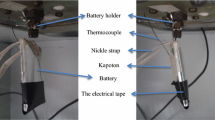Abstract
When a sodium-nickel chloride cell is discharged reversibly, heat is liberated. The amount of heat involved has been found from measured values of the open circuit voltage of the cell over a range of temperatures. The thermal capacity of a 40 A h cell has also been measured, at various states of discharge, and is found to be a linear function of the temperature and of the degree of discharge. The information has been combined to find the temperature changes which occur when a fully charged cell undergoes a reversible discharge-charge cycle. Complete discharge of the cell involves a temperature rise of some 30–35 K, depending on the starting temperature; the effect is reversed on charge. The techniques employed in these calculations could be applied to other cells in which all reactants and products of the cell reaction are pure phases, such as the sodium-sulphur cell or ZEBRA cells involving transition metals other than nickel.
Similar content being viewed by others
References
J. Coetzer, J. Power Sources 18 (1986) 377.
A. R. Tilley and R. J. Wedlake, Electric Vehicle Developments 6 (1987) 119.
P. T. Moseley, R. J. Bones, D. A. Teagle, R. A. Bellamy and R. W. M. Hawes, J. Electrochem. Soc. 136 (1989) 1361.
R. J. Bones, J. Coetzer, R. C. Galloway and D. A. Teagle, J. Electrochem. Soc. 134 (1987) 2379.
B. Cleaver and V. S. Sharivker, J. Electrochem. Soc. 142 (1995) 3409.
This cell is manufactured by Beta Research & Development, 50 Goodsmoor Road, Sinfin, Derby DE24 9GN, Great Britain. It has a maximum capacity of 40 A h.
Author information
Authors and Affiliations
Rights and permissions
About this article
Cite this article
Cleaver, B., Cleaver, D.J., Littlewood, L. et al. Reversible and irreversible heat effects in ZEBRA cells. J Appl Electrochem 25, 1128–1132 (1995). https://doi.org/10.1007/BF00242540
Received:
Revised:
Issue Date:
DOI: https://doi.org/10.1007/BF00242540




